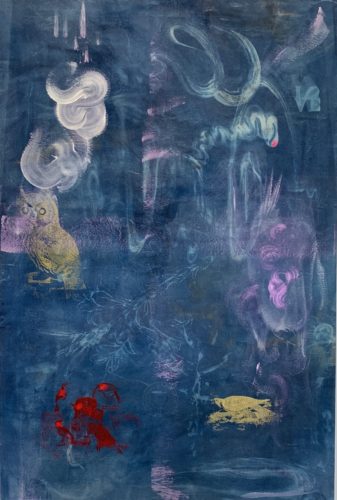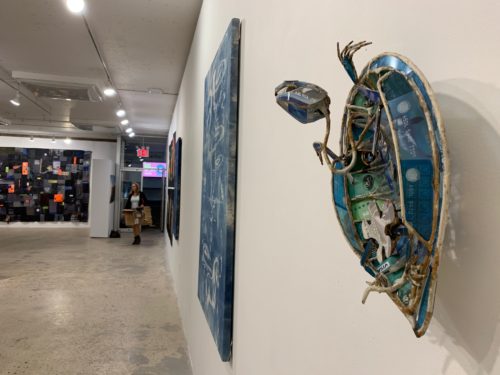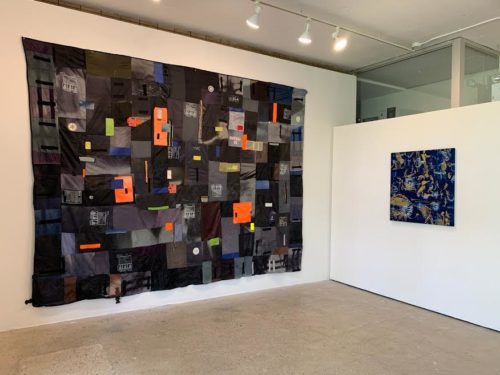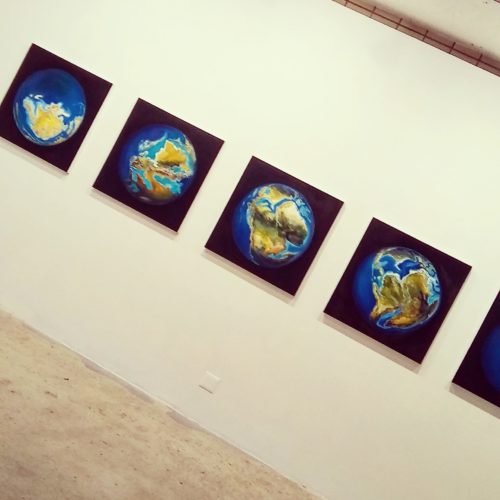Our earth is mortal. Like any child, she was born, and like any living being she will die. Her life will have been made of trillions of moments, and within each moment will live an infinite microcosm of tinier moments. The emergence of the Hawaiian islands from the violence of massive volcanoes. A father making the difficult choice to board a raft with his child at night, taking on the moniker of refugees. Granules of time as large as shifting continents and as small as tiny hands digging in the sand will come together to create the story of her life.
A moment revealed itself within the DeKalb Gallery at Pratt Institute in September. A pop-up show organized by artist and professor, Peggy Cyphers, titled “Anthropocene Island,” glowed with intention and meaning through the fishbowl glass wall of the gallery. The exhibition featured artists Suzanne Anker, Pam Longobardi, Sarah Olson, Christy Rupp, Kathleen Vance and Cyphers herself as they came together to observe and make sense of the dramatic point in time modern humans have found themselves in. A man-made epoch of invasion, colonization and migration, the Anthropocene has entirely “re-ordered the world as we know it,” Cyphers would say. With plastics replacing predators, and climate change pushing creatures of all kinds from their homes, the artists of Anthropocene Island asked us to consider the gravity of this moment while we are in it.
Approaching the gallery from the outside, I was first struck by the haunting glow of Kathleen Vance’s vintage steamer trunks. Titling this installation “Precious Cargo,” Vance constructs miniature traveling landscapes with rolling hills, vast pastures and functioning waterfalls. Lit from the inside with warm natural light, Precious Cargo sets the tone of the space with the gentleness and healing power of nature that is hard to obtain within the brick and concrete panopticon of our urban dwellings. It brought to mind the notion of Chinese gardens — intricate and curated “natural” environments that viewers are meant to imagine themselves exploring but can only admiring from the edges. The nature of Vance’s work makes it physically inaccessible but so psychically and emotionally vast that a viewer can imagine herself spending hours resting by the banks of miniature creeks. In addition to the themes of romantic naturalism and contemplation, Vance confronts our notions of ownership, because, truthfully, these are not your suitcases. This land “belongs” to someone else. Whether it was stowed away as nostalgic reminders of home, or stolen away in land grabs, the warmth within is also decidedly not yours. You can look, but you can’t touch. Vance addresses the complexities surrounding our containment of nature, water rights and ownership.
As you enter the gallery, the works of Suzanne Anker and Sarah Olson reverberate between one another. Anker’s group of “Vanitas” are aerially photographed petri dishes filled with meat, broken glass and flower petals. Ankers then 3d models these jarringly fleshy compositions to create a visual upset between our understanding of the natural and the digital. The photographs themselves were displayed as large scale velvety orbs that participate in conversation with Olson’s ever transforming planet Earths. “Earthtime” by Sarah Olson rips viewers out their human based measurements to the macroscopic clock face of planetary time. Our planet has been busy the past 500 million years and Olson predicts how it will continue to reshape itself with rising sea levels and changing shorelines. The paintings themselves are richly sculpted with representations of developing mountain ranges and dynamic coastlines. However, the implied brutality of an evolving climate for living creatures on the surface is piercing, even within the planets beauty. Held in concert with Anker’s microscopic environments, viewers are confronted with how small our existence is to the timeline of our Earth, but how grandiose our state of being is to us.
Tucked in the corner among the echoing planetoids of Anker and Olson is the iconic work of Christy Rupp. A skeletal turtle with bones constructed of credit cards hung on the wall belly-up made me feel the emptiness within my own stomach. I’ve seen Rupp’s skeletons several times over the past few years. Each time I see a new sculpture there is a layer of charm and wonder attached to my own childhood memories at the Smithsonian that is peeled away. During my first few encounters with the skeletons I was delighted by their construction in the same way I was amazed by the skeletons of extinct giant sloths in museums. Her piece “Turtle” didn’t fill me with wonder as much as it filled me with dread for our oceans, and I felt it’s sharp and soldered edges as if they were the elements of my own ribcage.
I carried that dread to the work of Pam Longobardi, who I felt held it with me. If Rupps work shoves viewers off the cliff of existential dread, Longobardi is the net that catches them. “Night Flag of Lesvos” is a patchwork abstract tapestry made of recovered life vests from migrants and refugees on the coast of Lesvos, Greece. Working through her platform Drifters Project, she works with refugees on site to create works of art to help generate income for the social and economic well-being of the islands inhabitants. In addition to donating her profits, Longobardi has disrupted the ever increasing flow of plastic into the ocean by collecting these life vests to create these works. This plastic carried children to safety and held families together afloat the Aegean sea, and now it continues to reinforce the meaning of a community’s power over adversity. In contrast, the geometric edges of sewn plastic allude to a harsh rigidity in form. Layered patches of grey and orange read as digital errors in computer coding. It’s as if the experiences of the human bodies they carried aren’t suited to fit into these mass produced rectangles of plastic. Longobardi asks viewers to hold all at once the cold reality of escaping violence, the human need for community, and the truth of what this migration means for our planet.
Peggy Cyphers’ paintings are noticeably different from her partners in Anthropocene Island, and she admitted as much when I spoke to her about it. Her surrender to material creates a relationship with the sun that is more collaborative than merely a relationship of function. The gestural layering of texture and brush marks carries with it an emotional translation of the narrative of water. Jetties and vortexes reveal themselves in and around the bodies of animals, and plant life that cannot exist without water. Inverted bodies carry ghost-like voices that then become entangled among the reeds of marks. Time works differently within a Cyphers painting, where dead and dying animals immortalized by early naturalists are captured by the sun as if they lived again. I also felt that Cyphers work “Heirs to the Sea” wasn’t engaged in some kind of critique, which made my experience with them more empathic. Her work was an encouragement to linger, to contemplate, and to wonder at the spiritual aspects of water and life. Other artists tell us that we should cherish our planet and Cyphers wants us to discover why.
When I left the DeKalb Gallery, I ruminated on the gathering of these six artists. All of them were women working with the themes of water (a historically female element), life (a historically female gift) and catastrophe (a historically easy thing to blame on a female). They performed as messengers, and some as oracles, of the ways we are losing and desperately grasping for control. “Anthropocene Island” was an emotionally jarring reflection on the critical position humans are in, and what choices that are made in the next few moments could mean for life.





At this critical juncture in human history artists respond to preserve beauty! The last refuge of the soul.